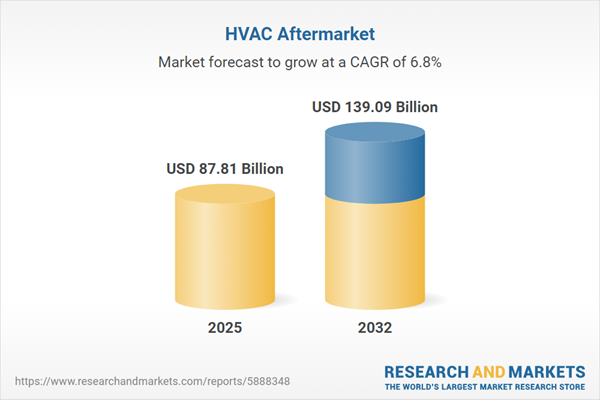Speak directly to the analyst to clarify any post sales queries you may have.
The HVAC aftermarket industry is undergoing significant transformation as organizations adapt to new technologies, sustainability imperatives, and evolving regulatory environments. Senior decision-makers must navigate a rapidly changing landscape, optimizing service models and supply chain strategies to drive growth and efficiency.
Market Snapshot: HVAC Aftermarket Market Size and Growth
The HVAC aftermarket market grew from USD 82.09 billion in 2024 to USD 87.81 billion in 2025. It is projected to expand at a CAGR of 6.81%, reaching USD 139.09 billion by 2032. Ongoing modernization of building systems, increased focus on decarbonization, and the adoption of digital service platforms are key market drivers. These trends are accelerating demand for both hardware and advanced services across diverse regions and customer segments.
Scope & Segmentation
This report delivers a comprehensive analysis of the HVAC aftermarket ecosystem, examining its most relevant segments, channels, and geographies:
- Service Types: Consulting, engineering (energy audits, system design), installation and commissioning (professional services, turnkey solutions), maintenance and repair (corrective, predictive, preventive programs), retrofit and replacement (component swaps, system upgrades).
- Distribution Channels: E-commerce (manufacturer websites, online retailers, third-party marketplaces), MRO specialists, OEM direct sales, specialized distributors, and wholesalers.
- End User Segments: Commercial (education, healthcare, hospitality, office, retail), industrial (chemicals, manufacturing, oil & gas, pharmaceuticals), and residential (multi-family buildings, single-family homes).
- Product Types: Air conditioners (central, portable, room), boilers (commercial and residential), ducting components (dampers, ducts, insulation), fans and blowers, furnaces (electric, gas, oil), heat pumps (air, ground, water source), and advanced HVAC controls (building management systems, control valves, sensors, thermostats).
- Regional Coverage: Americas (North America, Latin America), Europe, Middle East, Africa, and Asia-Pacific, encompassing all major country-level markets such as the United States, Canada, China, Germany, India, and others.
- Key Companies Analyzed: Carrier Global Corporation, Trane Technologies, Daikin Industries, Johnson Controls, Lennox International, Rheem Manufacturing, Emerson Electric, Honeywell, Mitsubishi Electric, Robert Bosch GmbH.
Key Takeaways for Senior Decision-Makers
- Digitalization is driving significant operational changes, with remote diagnostics, predictive analytics, and integrated monitoring solutions now essential for staying competitive in the HVAC aftermarket.
- As decarbonization targets become more stringent, companies are accelerating the adoption of low-global-warming-potential refrigerants, optimized system designs, and energy-efficient technologies throughout service and retrofit offerings.
- Omnichannel service delivery—blending e-commerce, specialist distributors, and direct channels—is reshaping customer experiences and shortening response times for aftermarket solutions.
- Shifting customer expectations demand seamless integration of digital touchpoints and personalized support, making it critical for aftermarket providers to invest in both technology platforms and skilled field service teams.
- Market leaders gain an edge by forming strategic partnerships, prioritizing research and development for next-generation solutions, and expanding regional capabilities through targeted acquisitions.
- Rigorous segmentation strategies enable organizations to customize offerings and unlock growth in both established and emerging regions as regulatory requirements evolve.
Tariff Impact on Supply Chains and Costs
Recently introduced U.S. tariff policies have created new operational complexities, increasing hardware sourcing costs and demanding agile supply chain management. Enterprises are diversifying vendor portfolios, collaborating with regional manufacturers, and re-engineering product designs to contain costs. Service providers are adjusting pricing and seeking value-added service opportunities to offset margin pressures. The emphasis has shifted toward building resilient, analytics-driven procurement models to secure continuity and cost effectiveness in a shifting trade environment.
Methodology & Data Sources
This report is based on a robust, multi-tiered research process. Primary research includes interviews with senior executives across service, manufacturing, and distribution segments. Secondary research draws on regulatory filings, market reports, patent data, and financial disclosures. Proprietary analytical frameworks ensure validation of findings and sensitivity to trend shifts in the HVAC aftermarket sector.
Why This Report Matters in the HVAC Aftermarket
- Enables senior leaders to benchmark strategy against comprehensive, up-to-date sector insights and competitive landscapes.
- Equips businesses with practical recommendations for technology adoption, supply chain optimization, and workforce development.
- Identifies actionable pathways to accelerate resilience, compliance, and sustainable growth in a rapidly evolving marketplace.
Conclusion
Senior executives who recognize the interplay of technology, regulation, and changing customer priorities can chart a sustainable competitive path forward. Robust analytics and proactive adaptation remain vital for continued success in the evolving HVAC aftermarket industry.
Additional Product Information:
- Purchase of this report includes 1 year online access with quarterly updates.
- This report can be updated on request. Please contact our Customer Experience team using the Ask a Question widget on our website.
Table of Contents
3. Executive Summary
4. Market Overview
7. Cumulative Impact of Artificial Intelligence 2025
Companies Mentioned
The companies profiled in this HVAC Aftermarket report include:- Carrier Global Corporation
- Trane Technologies PLC
- Daikin Industries, Ltd.
- Johnson Controls International PLC
- Lennox International Inc.
- Rheem Manufacturing Company
- Emerson Electric Co.
- Honeywell International Inc.
- Mitsubishi Electric Corporation
- Robert Bosch GmbH
Table Information
| Report Attribute | Details |
|---|---|
| No. of Pages | 190 |
| Published | November 2025 |
| Forecast Period | 2025 - 2032 |
| Estimated Market Value ( USD | $ 87.81 Billion |
| Forecasted Market Value ( USD | $ 139.09 Billion |
| Compound Annual Growth Rate | 6.8% |
| Regions Covered | Global |
| No. of Companies Mentioned | 11 |









